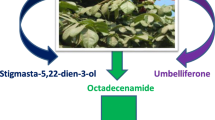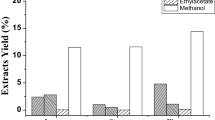Abstract
The present study was designed to isolate a potential compound from the extracts of Elytraria acaulis (E. acaulis) for ovarian cancer. n-Hexane, ethyl acetate, chloroform, acetone and methanol extract were taken using the Soxhlet method. Thin layer, column chromatography, NMR and MASS studies were done for the isolation and structural characterization of the compound. Finally, the novel compound (Z)-3-(2-methyl-3-oxoprop-1-en-1-yl) phenyl heptanoate was identified. MTT assay, cell morphology and cell cycle analysis were done to evaluate the anticancer property of the compound. In the MTT assay, the percentage of the cell viability treated with the isolated compound was decreased while increasing the concentration of the compound. Cancer cells treated with the isolated compound showed distinct morphological changes when compared to the control untreated cells. In the cell cycle analysis, the isolated compound induced a significant increase in the percentage of cells in G0/G1 phase and a decrease in the percentage of cells in the S phase and G2-M phase of the PA 1 cell lines. The cell cycle arrest induced by the isolated compound may account for its antiproliferative capacity. Hence, the novel compound isolated from E. acaulis can be a potent candidate in the designing of anticancer drugs.











Similar content being viewed by others
Data Availability
All data available from corresponding author by request.
References
Dsouza, D. R. N., Murthy, N. S., & Aras, R. Y. (2013). Projection of burden of cancer mortality for India, 2011–2026. Asian Pacific Journal of Cancer Prevention, 14, 4387–4392.
Kooti, W., Servatyari, K., Behzadifa, M., Asadi-Samani, M., Sadeghi, F., Nouri, B., & Marzouni, H. Z. (2017). Effective medicinal plant in cancertreatment, part 2: Review study. Journal of evidence-based complementary & alternative medicine, 22, 982–995.
Dikshit, R., Gupta, P. C., & Ramasundarahettige, C. (2012). Cancer mortality in India: A nationally representative survey. Lancet, 79, 1807–1816.
Sharma, D. C. (2016). Cancer data in India show new patterns. The Lancet Oncology, 17, 272.
Takiar, R., Nadayil, D., & Nandakumar, A. (2010). Projections of number of cancer cases in india (2010–2020) by Cancer Groups. Asian Pacific Journal of Cancer Prevention, 11, 1045–1049.
Gordaliza, M. (2007). Natural products as leads to anticancer drugs. Clinical and Translational Oncology, 9, 767–776.
Solowey, E., Lichtenstein, M., Sallon, S., Paavilainen, H., Solowey, E., & Lorberboum- Galski, H. (2014). Evaluating medicinal plants for anticancer activity. The Scientific World Journal, 2014, 1–12. https://doi.org/10.1155/2014/721402
Khare, C. P. (2007). Indian medicinal plants, an illustrated dictionary. Springer, New York, pp. 236. https://doi.org/10.1007/978-0-387-70638-2
Bhatt, R. P., & Sabnis, S. D. (1987). Contribution to the ethnobotany of Khedbrahma region of north Gujarat. Journal of Economic and Taxonomic Botany, 9, 139–145.
Jain, S. K., & Srivastava, S. (2003). Some folk herbal medicines for possible use in veterinary practices. Indian Journal of Traditional Knowledge, 2, 118–125.
Koshy, R. K., Raj Kapoor, B., & Azamthulla, M. (2012). Anti hyperglycemic activity of Elytraria acaulis Lind. on streptozotocin-induced diabetic rats. Medicinal & Aromatic Plants, 1, 1–6.
Venkatraji Reddy, G., VijayKumar, R., & Krishna Reddy, M. (2015). Preliminary phytochemical analysis and antioxidant activity of Elytrariaacaulis plant extracts. International Journal of Pharmaceutical Sciences Review and Research,30, 173–176.
Praveen kumar, R., Sukanyahdevi, E., Shruthilavanya, S., Vaishali, C., GospeliaNivetha, L., Chozhavendhan, S., & Bharathiraja, B. (2014). Evaluation of anti-septic and anti-inflammatory activity of Elytrariaacualis. International Journal of ChemTech Research, 6, 4166–4171.
Manigaandan, M., & Kolanjinathan, K. (2016). Qualitative phytochemical screening and antioxidant activity of Elytraria acaulis Lindau(Acanthaceae). Asian Journal of Pharmaceutical and Clinical Research, 9, 1–4.
Priya, P., Ramesh, S., & Sivamurugan, V. (2018). In vitro studies on the effect of methanolic extract of Elytraria acaulis on the glucose metabolism of Cotylophoron cotylophorum. International Journal of Green Pharmacy, 12, 688–694.
Deeptisarada, U., & Thiruthani, M. (2018). Spectroscopy analysis of the Siddha drug Nilakadambu Chooranam. International Journal of Current Research in Chemistry and Pharmceutical Sciences, 5, 31–33.
Mosmann, T. (1983). Rapid colorimetric assay for cellular growth and survival: Application to proliferation and cytotoxic assays. Journal of Immunological Methods, 65, 55–63.
Ciapetti, G., Cenni, E., Pratelli, L., & Pizzoferrato, A. (1993). In vitro evaluation of cell/biomaterial interaction by MTT assay. Biomaterials, 14(5), 359–364.
Mishell, B. B., Shiiqi, S. M., & Henry, C. (1980). Selected methods. In B. B. Mishell & S. M. Shiiqi (Eds.), Cellular Immunology (pp. 21–22). Freeman.
Mazumder, K., Biswas, B., Raja, I. M., & Fukase, K. (2020). A review of cytotoxic plants of the Indian subcontinent and a broad-spectrum analysis of their bioactive compounds. Molecules,25(8), 1904. https://doi.org/10.3390/molecules25081904
Ghagane, S., Puranik, S., Kumbar, V., Nerli, R., Jalalpure, S., Hiremath, M., Neelangund, S., & Aladakatti, R. (2017). In vitro antioxidant and anticancer activity of Leea indica leaf extracts on human prostrate cancer cell lines. Integrative Medicine Research, 6, 79–87.
Soltanian, S., Sheikhbahaei, M., & Mohamadi, N. (2017). Cytotoxicity evaluation of methanol extracts of some medicinal plants on P19 embryonal carcinoma cells. Journal of Applied Pharmaceutical Science, 7, 142–149.
Yu, J., Ma, Y., Drisko, J., & Chen, Q. (2013). Antitumor activities of Rauwolfia vomitoria extract and potentiation of carboplatin effects against ovarian cancer. Current Therapeutic Research, 75, 8–14.
Shaikh, R., Pund, M., Dawane, A., & Iliyas, S. (2014). Evaluation of anticancer, antioxidant, and possible anti-inflammatory properties of selected medicinal plants used in Indian traditional medication. Journal of Traditional and Complementary Medicine, 4, 253–257.
Hengartner, M. O. (2000). The biochemistry of apoptosis. Nature, 407, 770–776.
Brown, J. M., & Attardi, L. D. (2005). The role of apoptosis in cancer development and treatment response. Nature Reviews Cancer, 5, 231–237.
MacKenzie, S. H., & Clark, A. C. (2008). Targeting cell death in tumors by activating caspases. Current Cancer Drug Targets, 8, 98–109.
Persidis, A. (1999). Cancer multidrug resistance. Nature Biotechnology,1794–95.
Yang, X. H., Sladek, T. L., Liu, X., Butler, B. R., Froelich, C. J., & Thor, A. D. (2001). Reconstitution of caspase 3 sensitizes MCF-7 breast cancer cells to doxorubicin- and etoposide-induced apoptosis. Cancer Research, 61, 348–354.
Chew, E. H., Nagle, A. A., Zhang, Y., Scarmagnani, S., Palaniappan, P., & Bradshaw, T. D. (2010). Cinnamaldehydes inhibits thioredoxin reductase and induce Nrf2: Potential candidates for cancer therapy and chemoprevention. Free Radical Biology & Medicine, 48, 098–111.
Nagle, A. A., Gan, F. F., Jones, G., So, C. L., Wells, G., & Chew, E. H. (2012). Induction of tumor cell death through targeting tubulin and evoking dysregulation of cell cycle regulatory proteins by multifunctional cinnamaldehydes. PLoS One,7, e50125.
Lin, L. T., Wu, S. J., & Lin, C. C. (2013). The anticancer properties and apoptosis-inducing mechanisms of cinnamaldehyde and the herbal prescription Huang-Lian-Jie-Du-Tang (Huáng Lián Jiě Dú Tang) in human hepatoma Cells. Journal of Traditional and Complementary Medicine, 3, 227–233.
Nivethika, S., Samarakoon, S. R., Adhikari, A., Ediriweera, M. K., Tennekoon, K. H., Malavige, N., Thabrew, I., & Shrestha, R. S. (2018). Cytotoxic and apoptotic effects of govaniadine isolated from Corydalis govaniana wall. Roots on Human Breast Cancer (MCF-7) Cells. BioMed Research International, 18, 1–11.
Badmus, J.A., Ekpo, O. E., Hussein, A. A., Meyer, M., & Hiss, D.C. (2015). Antiproliferative and apoptosis induction potential of the methanolic leaf extract of Holarrhena floribunda (G. Don). Evidence-based complementary and Alternative Medicine, https://doi.org/10.1155/2015/756482.
Svejda, B., Moser-Aguriano, V., Sturm, S., Hoger, H., Ingolic, E., Siegl, V., Stuppner, H., & Pefragner, R. (2010). Anticancer activity of novel plant extracts from Trailliaedoxa gracilis in human carcinoid KRJ-I cella. Anticancer Research, 30(1), 55–64.
Cotter, T. G. (2009). Apoptosis and cancer: The genesis of a research field Nature reviews. Cancer, 9(7), 501–507.
Thangaraj, K., Balasubramanian, B., Park, S., Natesan, K., Liu, W., & Manju, V. (2019). Orientin induces G0/g1 cell cycle arrest and mitochondria mediated intrinsic apoptosis in human colorectal carcinoma HT29 cells. Biomolecule, 9(9), 418. https://doi.org/10.3390/biom9090418
Patel, S., Kumar, L., & Singh, N. (2015). Metformin and epithelial ovarian cancer therapeutics. Cell Oncology (Dordrecht), 38(5), 365–375.
Author information
Authors and Affiliations
Contributions
PP: conceptualisation, manuscript writing, formal analysis; MA: compound isolation; VSC: anticancer studies; SAM: formal analysis; VS: spectral analysis and writing; RLS: characterisation.
Corresponding authors
Ethics declarations
Ethical Approval
Not applicable.
Consent to Participate
Not applicable.
Consent for Publication
All authors agree to publish the article.
Competing Interests
The authors declare no competing interests.
Additional information
Publisher's Note
Springer Nature remains neutral with regard to jurisdictional claims in published maps and institutional affiliations.
Rights and permissions
About this article
Cite this article
Priya, P., Anbarasu, M., Christina, V.S. et al. Isolation of Potential Compound from the Leaves of Elytraria acaulis and Evaluating Its Therapeutic Properties Using In Vitro Studies Against Ovarian Cancer. Appl Biochem Biotechnol 194, 5607–5626 (2022). https://doi.org/10.1007/s12010-022-04048-7
Accepted:
Published:
Issue Date:
DOI: https://doi.org/10.1007/s12010-022-04048-7




